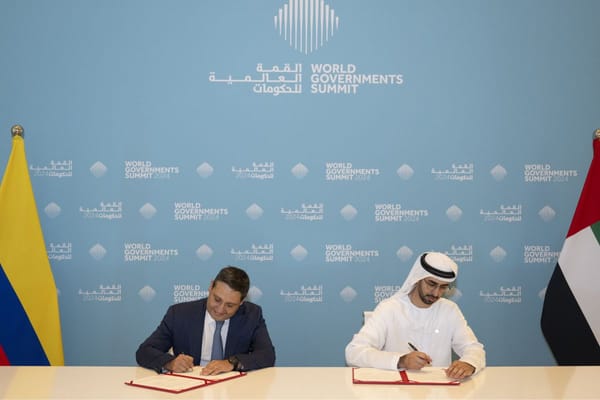A new report, titled “In Search of Productivity: The Next $50 Trillion in the Global Economy", revealed that Gulf Cooperation Council (GCC) countries could accelerate the region’s GDP growth over the next decade from 3.8 percent to 5.4 percent.
This acceleration would add more than $2.5 trillion to GDP over the next 10 years, the research, launched by the World Governments Summit in partnership with Strategy& Middle East, part of the PwC network, suggested.
The report introduced a new way of measuring productivity that includes dimensions critical for our age, such as environmental impact, health, innovation, and the quality of institutions. The report uses this new framework to estimate the potential upside to the GDP of Gulf Cooperation Council (GCC) economies if they can improve on their weakest determinant of their productivity performance.
To unlock the upside of economic growth and prosperity, GCC countries can strategically improve their productivity performance by leveraging the Productivity Potential Index (PPI) to identify the weakest determinant of productivity and then lifting that to the level of the best-in-class countries.
Productivity, a measure of economic performance that compares the amount of goods and services produced with the inputs needed to produce them, is the lifeblood of modern societies, affecting aspects that range from global competitiveness to individual quality of life. Yet, until now, traditional measures of productivity have not included increasingly important dimensions such as climate change, biodiversity loss, social change, aging populations, and other 21st century challenges.
Moreover, traditional measures of productivity describe what happened in the past, rather than providing decision-makers with a future-focused analysis of what can be potentially achieved.
The new method of measuring productivity introduced in this report is forward-looking and gives countries the tools with which to identify their overall productivity potential and the potential drivers that could accelerate it. It adds inputs for social capital, natural capital, and the quality of institutions to the traditional measures of labour and human capital, physical capital, and innovation and intangible capital.
The new framework takes the form of a PPI. It comes with an online policy simulator that enables users to see how the 25 countries in the first sample stack up against each other across 19 criteria grouped into six categories. The estimated potential productivity that the index provides answers the question ‘What would we expect Country A’s productivity to be, given its endowments, if it used those endowments as well as the average country across the sample?’
“The potential boost to GCC economic growth from a better understanding of the determinants of productivity is impressive and, if its findings are acted upon, this could substantially improve the lives of people in the region over the next decade,”
said Chadi Moujaes, partner with Strategy&, part of the PwC network.
“We hope our research will help governments everywhere identify more accurately where they can make a significant difference to their productivity and economic growth performance.”
“At a time when the world is looking to become more sustainable, it is essential to have appropriate tools for measuring economic progress that take into account criteria such as the environment and biodiversity, along with a range of social capital measurements,”
said Dima Sayess, partner and Ideation Center lead at Strategy&.
“This new index fills an important gap.”
A modern index for changing times
The benefits of adopting this new PPI are threefold. First, the index enables countries to more easily identify both the strongest and weakest aspects of their economic performance; second, it highlights which factors can become the biggest game changers for productivity and economic growth, using benchmarks from best-performing countries; and finally, the new index provides policymakers with a practical view of how they can close gaps and leapfrog performance, with the goal of attaining the levels already reached by economies with the highest productivity.
The index is modern not only in its conception but also in its calculations. With the help of a machine-learning process, the authors estimated country-specific potential productivity with data on the 19 criteria determining productivity, across all countries and variables. This enables users of the simulator to identify areas that individual countries would specifically need to focus on if they wanted to boost their own productivity.
The analysis underpinning the index is based on the latest academic thinking about productivity and its robustness has been tested with international economists who specialize in this field.
Report insights
The PPI is expanding and new countries will be added to it in the coming months. Alongside the potential for GCC countries to add $2.5 trillion to their GDP over the next decade, several other important insights emerge from this first edition.
These include the following:
- Across the sample, human and physical capital remain the primary determinants of productivity. These are followed closely by intangibles: institutional quality, scientific research, and innovation are all top five predictors. Mainstream economic statistics struggle to capture these intangibles, which is one of the reasons the PPI is needed.
- There are key differences in the primary drivers of productivity across different types of economies. In developing countries, physical capital, life expectancy, institutional quality, and internet access are the most important predictors. In OECD countries, by contrast, inequality is the most important predictor, followed by physical and human capital. In the Gulf Cooperation Council countries, chief indicators include human capital (including physical health and education) and natural capital (including water stress, natural resources, and air pollution).
- Finally, the new index is fully aligned with, supports, and responds to the Beyond GDP movement, recently highlighted by the UN Secretary-General. The results indicate that the sources of growth and innovation in economies are increasingly aligned with decarbonization and social cohesion. Thus, the PPI will be a useful indicator not only for understanding the future sources of growth but for delivering the Sustainable Development Goals and the 2030 Agenda.
More than 4,000 participants from the public and private sectors participated in 110 interactive sessions at WGS 2024, including 200 speakers from 80 international, regional, and intergovernmental organizations including the UN, the World Bank, the International Monetary Fund, the World Health Organisation, the International Atomic Energy Agency and the Arab League. It welcomed eight Nobel prize winners and provided a platform for 23 ministerial meetings in the presence of more than 300 ministers. In partnership with a select group of knowledge partners, the Summit launched more than 25 strategic reports, focusing on the most important practices and trends in vital sectors.
News Source: Emirates News Agency









